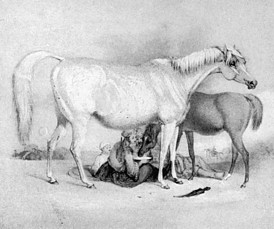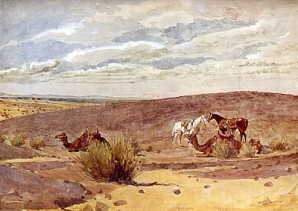|



A DESERT-BORN LEGEND

by Joan L. Schleicher, ©2003
 The Heirloom taproot tendrils down through the centuries, into stud farms of Europe and Egypt, over desert sands of Arabia, until it touches a single wild mare captured by a shepherd in the highlands of Yemen before history began. The Heirloom taproot tendrils down through the centuries, into stud farms of Europe and Egypt, over desert sands of Arabia, until it touches a single wild mare captured by a shepherd in the highlands of Yemen before history began.
In a tale whispered through the ages, it is rumored that the mare was born from the breath of the Creator; no animal on earth could improve upon her nature or form. It is said that she was in foal and gave birth to a colt; in good time, they were mated. Generation after generation, her descendants replicated her perfect beauty, intelligence, and agile strength. The shepherd named her Baz. She is the Eve of the Arabian horse breed.
For thousands of years, the shepherd's descendants bred the pure stock of Baz. Her family grew and branched out, as did her caretaker's, until the desert lands were renowned for both the nomadic Bedouin tribes and their unique hot-blooded horses.
Today, the purebred Arabian horse is acknowledged as the progenitor of every modern equine breed. However, only within the last millennium have horse breeders from non-Bedouin societies attempted to obtain and reproduce the desertbred horse itself. Whether enthusiasts traveled to Arabia in pursuit of stock, as did Wilfrid and Lady Anne Blunt, or sent knowledgeable agents, as did the pashas of nineteenth- and twentieth-century Egypt, they encountered the same two challenges confronting us now: How can the authenticity of an Arabian horse be determined and how can the authentic Arabian be perpetuated within physical and cultural climates so different from its birthplace? A specialized genre of literature has accumulated over the years in consideration of these concerns and offers touchstones to Arab horse preservationists, including Heirloom.
Among the memoirs published by European adventurers who traveled through the Middle East a century or two ago are descriptions of Bedouin ways, beliefs, and possessions—the most valued of which were their horses. A typical report mentions the breed's refined beauties, marvels over its remarkable capacity to survive in desert extremes, and admires its stamina, speed, and courage.
Of foremost importance to the Bedouin was the horse's purity of blood. The pedigrees of their horses were as familiar to the tribe as their own ancestry. The information was not kept by a registry. Unlike written records that can contain errors or omissions, these genealogies were inextricably preserved within the oral transmission of Bedouin culture and ensured by its rigorous integrity. Roger Upton documents this custom after his journey in search of purebreds in 1874:
|
In the desert we neither saw any written pedigrees of horses, nor heard of any; that is to say, there is no custom of keeping written pedigrees. It must be remembered that there are few, very few indeed, in the desert who can write; but most of the Shaykhs of important tribes keep a secretary. Every horse, however, has a pedigree; the breeding of each one is well known. |
|
Half a century after Upton's trip, W. R. Brown traveled to Arabia with Carl Raswan. Their expedition serves as the focal point for Brown's definitive study, The Horse of the Desert, including a description of the relationship between the horse and the Bedouin:
|
To know the Arabian horse, one should first understand that which made him—Arabia and the Arabs.... In no other country is that animal so esteemed, and in no other are his noble qualities of swiftness, endurance, temper, and attachment to man so finely developed.... The Bedouin lives by tradition. His own genealogy and that of his horse is handed down from father to son, and is one of the few topics of conversation during the hours devoted by Europeans to reading and writing. Pure breeding has become incorporated as one of his laws of existence. |
|
During his visit to the Middle East, Brown was able to study Arab horses in the ancient caravan-destination cities surrounding Desert Arabia—Baghdad, Damascus, Aleppo, Cairo—and while in the latter, toured the stud of Prince Mohamed Aly, "one of the choicest in the world." In 1935-1936, the Prince published his two important books on the history of purebred breeding in Egypt, in which his comments concur with those of Upton and Brown:
|
The pedigrees of my horses date back a hundred years, a phenomenal span for the east. In days gone by Arabs, being Nomads, had no pen and ink to record the pedigrees of their animals. The word of the chief was law. His statement that a horse was a pure-bred was as good as a written guarantee. |
|
Prince Mohamed Aly added a warning to the reader that the honor code, through which the authenticity of the breed had been safeguarded for so long, was now endangered:
|
This was only possible in the olden days, for during the last thirty years the Arabs have come into contact with the civilized world, and, realizing their need of money, have turned these "guarantees" into a commercial proposition. For two or three pounds you can get their testimony that the horse you have bought is a pure-bred Arab. |
|
These few words highlight the critical difference in needs and values that separates nomadic and settled cultures. A fuller expression was provided nearly a century earlier by A. H. Layard in 1849, as he explained why the Bedouin resists selling his horse, no matter how high the price offered:
|
... [H]e is entirely dependent upon her for his happiness, his glory, and, indeed, his very existence. An Arab possessing a horse unrivalled in speed and endurance ... is entirely his own master, and can defy the world.... Without his mare, money would be of no value to him. It would either become the prey of someone more powerful and better mounted than himself, would be spent in festivities, or be distributed among his kinsmen. He could only keep his gold by burying it in some secret place, and of what use would it be then to one who is never two days in the same spot...? |
|
The testimonies of these authorities seem to offer simple advice for determining the authenticity of an Arab horse, in any era—consider the source of a horse, its lineage, and also the nature of both its breeder and owner; what are their values and what goals do they pursue? If they are asil, so will be their statements about a horse.
Once the authentic Arabian has been obtained, what breeding choices will perpetuate the revered qualities of the desert horse through future generations? W. R. Brown made the following observation:
|
If conformation and pedigree cannot be combined in one individual, the Bedouin Arab always chooses pedigree; and that quite rightly. If the blood is kept pure, desirable conformation in the mare may offset that lacking in the stallion, and none of these hidden excellences called blood, which affect disposition, courage, intelligence and refinement, will be lost. |
|
Brown recalled the words of Charles Guarmani who concluded his informative 1864 study of the desert nomad's horse with adamant advice:
|
... [T]he purer the animal's breed the better will be the result of preserving him in his primitive condition, not to speak of preserving his power of transmitting his qualities to his progeny, so that in scouring the deserts in search of stallions for a complete regeneration of breeds, our sole aim must be to select those which belong to the first category, to the true asil, the ancient Safinat, always Safinat; and absolutely to refuse all others, be they ever so beautiful and even to all appearance better endowed and better formed. |
|
Guarmani's advice was reiterated in the language of modern science by the animal geneticist, Dr. Frederik Bakels, in his 1979 address to the Asil Club in Germany:
|
The asil horses of the Bedouin achieved great fame for their hardiness, endurance, character, and intelligence. These characteristics lie within what we call constitution. Constitution may be subdivided into the performance dispositions of individual organs: nervous system, hormone glands, circulation system, respiratory system, digestive system, locomotive system, etc.... Away from the desert, Arabian horses rarely underwent constitutional tests (e.g., long-distance rides) as a basis for selection and mating. Hence, origin is still the best guarantee of quality and transmission capacity in an Arabian horse. The ideal origin requires that all ancestors be traced, without interruption, to the horses of the Bedouin. |
|
From the times of the earliest writings by visitors to Desert Arabia, the Arab horse has been recognized as a primal animal. None of the texts describe how to improve the Bedouin horse and many consider how to conserve it. In the light of this history, Arab horse breeding appears to be homologous to preservationist breeding.
A hundred years ago, when Guarmani recorded his memoirs, he addressed readers who could go to Desert Arabia and export horses to other countries. However, in the twentieth century that option became nearly impossible due to many changing circumstances in the Middle East. Concerned breeders began to work together to locate and conserve the existing asil bloodstock, perhaps recognizing a factor noted by Carl Raswan:
|
The 'temptation' to 'improve' on almost everything in our 'creation' is only too natural-and 'harmless' as long as we keep untouched (aside from our 'laboratories' and 'research-centers' ...) some of the original 'specimens,' so that we retain for all times here and there a 'nucleus' ... but man's curiosity often overwhelms him and he destroys forever the original. |
|
According to Dr. Georg Wenzler, the Asil Club was organized in 1974 to encourage serious breeders "to remember once more the origin of our Arabian horses and to fall back upon the pure-bred performance horse of the desert," in contrast to the prevailing tendency toward the "worship of grace and beauty for themselves alone, so as to make the horse a mere object for the show-ring." In the Foreward to Asil Arabians III (1985), W. Georg Olms summarizes modern efforts to cultivate the desert seed:
|
A function from which the World Arabian Horse Association is barred, The Asil Club, Al Khamsa Inc., and Pyramid Society have assumed; they separately register breeds which are to be regarded as asil, according to Bedouin tradition. Their horses exclusively trace to Bedouin breeding on the Arabian Peninsula. They deserve to be specially cared for, as they are a "gene-pool" of immense importance for all breeds of pure-bred Arabians as well as for horse breeding as a whole; they must not be lost in the total stock. |
|

Midday Halt on the March, by Lady Anne Blunt
|

|
|
|
